April is the time of year when the snake’s head fritillaries are blooming across Lugg Meadows, and if you haven’t been to see them yet then it is well worth a visit. Our Lugg Meadows reserve is one of a number of sites we manage along the Lugg valley and helps us to protect and showcase the incredible wildlife that can be found here. Along with landowners, volunteers and local groups we have been working to help support and protect the Lugg Valley and we want to share some of the excellent work that’s been happening with you.
Collaborative conservation in Herefordshire's Lugg Valley
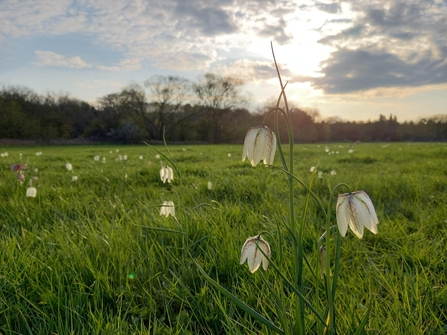
Snake's head fritillaries on Lugg Meadow (c) Katherine Beasley
Lugg Meadows and curlew
Curlew declined by 46% across the UK from 1994 to 2010 and the species was added to the UK red list in December 2015. The exact number of breeding pairs of curlew in Herefordshire is unknown but in 2022 it was estimated to now be less than 25 pairs and only two young were known to have reached the fledging stage.
Floodplain meadows like the Lugg Meadows reserve are key breeding sites for curlew but nature reserves alone don’t provide enough space for many breeding pairs. In 2023 we are excited to be working with local farmers bordering Lugg Meadows to monitor the curlew on their land as well as the meadows. With the support of volunteers and local curlew experts from the Herefordshire Ornithological Club we hope to ring and satellite track a number of birds so that we can better understand their movements and help support them in the future.
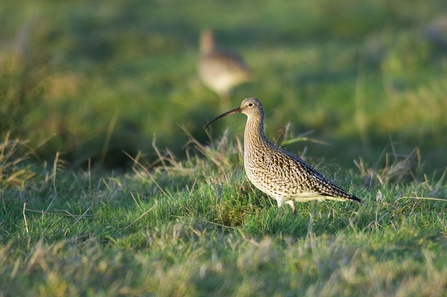
Curlew (c) John Bridges
Restoring Our Amazing Rivers and other farmland projects
During the past four years, we’ve visited 90 farms to talk about ways to help nature recover.
Actions like planting a winter cover crop or improving soil health can help to reduce the amount of soil washed into the river. This helps the farmer maintain their fields but also helps the health of the river as less silt ends up in the water course.
The introduction of buffer strips and improvements to separation between clean and dirty water can help reduce pollutants entering the river keeping our rivers cleaner.
Introducing winter bird seed planting or the planting of wild flowers can provide food for birds, invertebrates and small mammals, increasing the amount of wildlife on our farms and in our river corridor.
As part of a collaborative project with the Wye and Usk Foundation (WUF) and the Wye Valley Area of Outstanding Natural Beauty (AONB) and through funding from the Environment Agency (EA) one of our farm advisors worked with landowners in the Lugg catchment between 2019 and 2022. We worked to identify a range of actions they could take as part of Government Environmental Schemes which would help wildlife on their farms and benefit the river.
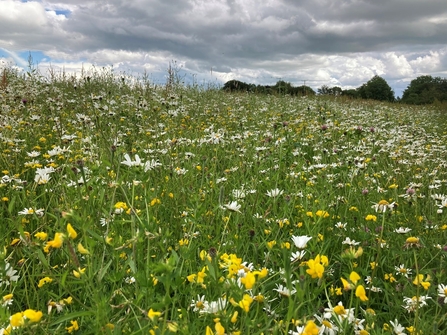
Fantastic wildflower nectar mix strip around margins of arable fields, absolutely buzzing with bees! (c) Claire Spicer
Over the course of the project we visited 90 farms and helped 18 sign up to schemes like those mentioned above. Every one of these will make a difference to the Lugg.
Further funding from the EA supported capital works on a number of farms where we were able to restore farm ponds, plant 2km of new hedgerows and in one case dig attenuation ponds. All of these actions can help to hold water on the land, either in the ponds or within the additional vegetation in hedgerows. It slows the pace of water reaching the river, reducing the likelihood and severity of flooding further downstream. Actions like these are referred to as Natural Flood Management.
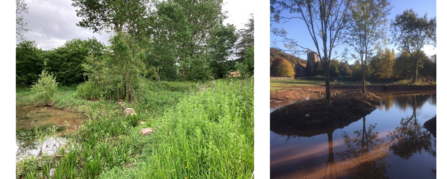
Pond restoration: before & after, Lugg Valley (c) Claire Spicer. Once recolonised it will be a great place for wildlife especially wading birds.
More Natural Flood Management work was funded by Herefordshire Council within the Wellington Brook area.
Implementing Natural Flood Management can help reduce the impact of flooding for local communities but also provides excellent new habitats for wildlife. We look forward to seeing the variety of species visiting the new ponds and hope that the increased hedgerows will help small mammals move through the landscape as well as providing food and nesting space for birds.
Trees are an important part of river banks and river corridors, their roots help provide stability to the banks as well as sheltered spaces for nesting or breeding, the shade from their leaves keeps cool areas for fish, especially important during hot summers when water levels are low. Alongside the Wye Valley AONB we have worked with landowners to help improve the health of trees along the river banks, including pollarding and coppicing which increases the longevity of the trees, removing diseased trees to make way for new healthy saplings to grow and where needed removing fallen trees from the river.
Wetland stepping stones
In 2020 we purchased our Oak Tree Farm reserve and we are working to create a new wetland site here which will form part of a corridor of wetland sites through the lower Lugg valley. You can read more about our Oak Tree Farm plans here.
Along with Bodenham lake, Wellington Gravel pits and Lugg Meadows our new wetland site will help wildlife move through the landscape, providing feeding and breeding site for birds, mammals and invertebrates. Working with landowners along the Lugg valley helps to connect these vital sites, turning a series of stepping stones into a solid corridor.
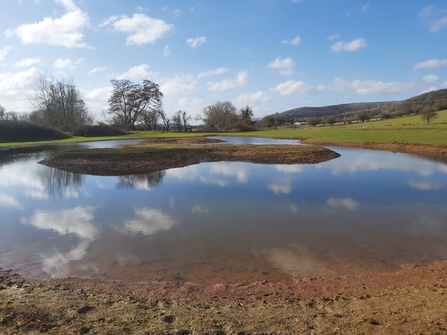
Newly created pond with islands_Oak Tree Farm
Working across the catchment
Rivers are complex systems and the Lugg is no different, with tributaries flowing in along its length. In order to see a big impact on the river we need to work along the entirety of the catchment and we hope to continue our work with landowners, volunteers and local groups to help improve the health of the whole river.
If you own or manage land along the Lugg catchment and would be interested in working with us to explore options for land management along the river banks please get in contact with us.
Sarah King: s.king@herefordshirewt.co.uk

